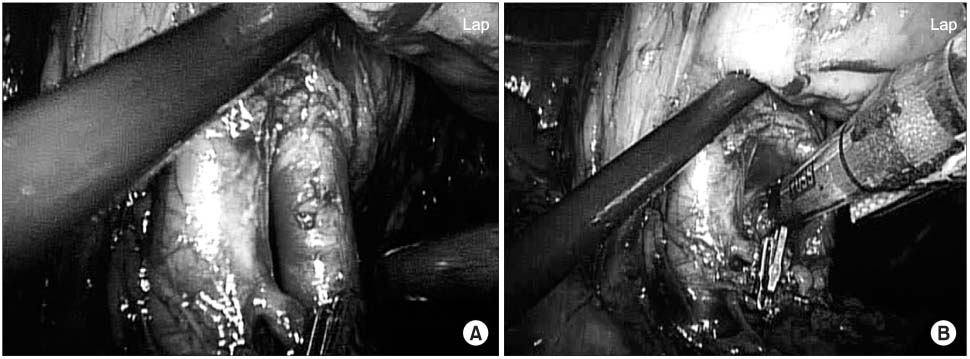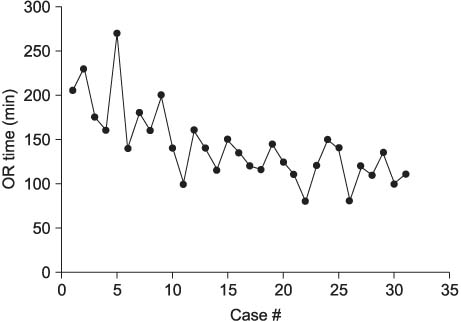Korean J Urol.
2006 Sep;47(9):968-973. 10.4111/kju.2006.47.9.968.
Laparoscopic Transperitoneal Radical Nephrectomy for Treating of Renal Cell Carcinoma
- Affiliations
-
- 1Department of Urology, Urological Science Institute, Yonsei University College of Medicine, Seoul, Korea.khrha@yumc.yonsei.ac.kr
- KMID: 2294093
- DOI: http://doi.org/10.4111/kju.2006.47.9.968
Abstract
- Purpose
Laparoscopic radical nephrectomy has emerged as a feasible treatment option for patients with clinically localized renal cell carcinoma. We evaluated the clinical efficacy and oncologic safety of laparoscopic radical nephrectomy.
Materials and Methods
Between April 2004 and October 2005, 31 laparoscopic radical nephrectomies were performed for clinically localized, stages cT1/2 NXMX, pathologically confirmed renal cell carcinoma. The clinical parameters including the operative time and the learning curve, the estimated blood loss, the postoperative hospital stay and the recurrence rate were evaluated.
Results
All procedures were completed laparoscopically via transperitoneal approach. There were no complications. The mean operative time was 140.6 minutes (range: 80-270) and the mean blood loss was 230.4ml (range: 30-800). The mean postoperative hospital stay was 4.9 days (range: 3-9) and all patients had satisfactory outcomes with objective cure on the follow up imaging studies. No patient had laparoscopic port site, wound or renal fossa tumor recurrence during the follow up periods (mean: 13 months).
Conclusions
Laparoscopic transperitoneal radical nephrectomy can be a safe and effective treatment. It could be considered as a primary procedure for treating localized renal cell carcinoma.
Keyword
MeSH Terms
Figure
Reference
-
1. Robson CJ. Radical nephrectomy for renal cell carcinoma. J Urol. 1963. 89:37–42.2. Clayman RV, Kavoussi LR, Soper NJ, Dierks SM, Meretyk S, Darcy MD, et al. Laparoscopic nephrectomy: initial case report. J Urol. 1991. 146:278–282.3. Kerbl K, Figenshau RS, Clayman RV, Chandhoke PS, Kavoussi LR, Albala DM, et al. Retroperitoneal laparoscopic nephrectomy. Laboratory and clinical experience. J Endourol. 1993. 7:23–26.4. Ono Y, Sahashi M, Yamada S, Ohshima S. Laparoscopic nephrectomy without morcellation for renal cell carcinoma: report of initial 2 cases. J Urol. 1993. 150:1222–1224.5. McDougall EM, Clayman RV, Elashry OM. Laparoscopic radical nephrectomy for renal tumor: the Washington University experience. J Urol. 1996. 155:1180–1185.6. Cadeddu JA, Ono Y, Clayman RV, Barrett PH, Janetschek G, Fentie DD, et al. Laparoscopic nephrectomy for renal cell cancer: evaluation of efficacy and safety: a multicenter experience. Urology. 1998. 52:773–777.7. Portis AJ, Yan Y, Landman J, Chen C, Barrett PH, Fentie DD, et al. Long-term followup after laparoscopic radical nephrectomy. J Urol. 2002. 167:1257–1262.8. Saika T, Ono Y, Hattori R, Gotoh M, Kamihira O, Yoshikawa Y, et al. Long-term outcome of laparoscopic radical nephrectomy for pathologic T1 renal cell carcinoma. Urology. 2003. 62:1018–1023.9. Makhoul B, de la Taille A, Vordos D, Salomon L, Sebe P, Audet JF, et al. Laparoscopic radical nephrectomy for T1 renal cancer: the gold standard? A comparison of laparoscopic vs open nephrectomy. BJU Int. 2004. 93:67–70.10. Dunn MD, Portis AJ, Shalhav AL, Elbahnasy AM, Heidorn C, McDougall EM, et al. Laparoscopic versus open radical nephrectomy: a 9-year experience. J Urol. 2000. 164:1153–1159.11. Gill IS, Meraney AM, Schweizer DK, Savage SS, Hobart MG, Sung GT, et al. Laparoscopic radical nephrectomy in 100 patients: a single center experience from the United States. Cancer. 2001. 92:1843–1855.12. Ono Y, Kinukawa T, Hattori R, Yamada S, Nishiyama N, Mizutani K, et al. Laparoscopic radical nephrectomy for renal cell carcinoma: a five-year experience. Urology. 1999. 53:280–286.13. Otani M, Irie S, Tsuji Y. Port site metastasis after laparoscopic nephrectomy: unsuspected transitional cell carcinoma within a tuberculous atrophic kidney. J Urol. 1999. 162:486–487.14. Ahmed I, Shaikh NA, Kapadia CR. Track recurrence of renal pelvic transitional cell carcinoma after laparoscopic nephrectomy. Br J Urol. 1998. 81:319.15. Kadji JF, Armand C, Gimbergues P, Blanc F, Tostain J. Retrospective comparative study of extended nephrectomies by surgery and by retroperitoneal laparoscopy. Prog Urol. 2001. 11:223–230.16. Janetschek G, Jeschke K, Peschel R, Strohmeyer D, Hening K, Bartsch G. Laparoscopic surgery for stage T1 renal cell carcinoma. Radical nephrectomy and wedge resection. Eur Urol. 2000. 38:131–138.17. Chan DY, Cadeddu JA, Jarrett TW, Marshall FF, Kavoussi LR. Laparoscopic radical nephrectomy: cancer control for renal cell carcinoma. J Urol. 2001. 166:2095–2099.18. Nambirajan T, Jeschke S, Al-Zahrani H, Vrabec G, Leeb K, Janetschek G. Prospective, randomized controlled study: transperitoneal laparoscopic versus retroperitoneoscopic radical nephrectomy. Urology. 2004. 64:919–924.19. Oh CK, Rha KH, Yang SC. A comparison of open, laparoscopic, and video-assisted minilaparotomy radical nephrectomy. Korean J Urol. 2005. 46:925–930.20. Fentie DD, Barrett PH, Taranger LA. Metastatic renal cell carcinoma after laparoscopic radical nephrectomy: long-term follow-up. J Endourol. 2000. 14:407–411.21. Castilho LN, Fugita OE, Mitre AI, Arap S. Port site tumor recurrences of renal cell carcinoma after videolaparoscopic radical nephrectomy. J Urol. 2001. 165:519.22. Iwamura M, Tsumura H, Matsuda D, Kurosaka S, Yoshida K, Baba S. Port site recurrence of renal cell carcinoma following retroperitoneoscopic radical nephrectomy with manual extraction without using entrapment sac or wound protector. J Urol. 2004. 171:1234–1235.
- Full Text Links
- Actions
-
Cited
- CITED
-
- Close
- Share
- Similar articles
-
- A Case of Renal Cell Carcinoma with Hyperglycemia Corrected after Radical Nephrectomy
- The Early Experience of Laparoscopic Radical Nephrectomy: Laparoscopic versus Open Radical Nephrectomy
- Incidentally Found Port Site Metastasis followings Laparoscopic Radical Nephrectomy for a Renal Cell Carcinoma
- Laparoscopic Radical Nephrectomy: Results and Oncological Outcome
- Comparison of Hand-assisted Laparoscopic Versus Retroperitoneo-scopic Radical Nephrectomy



